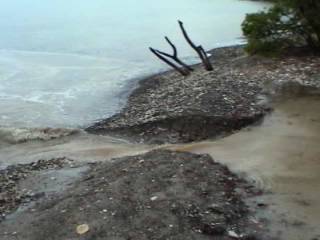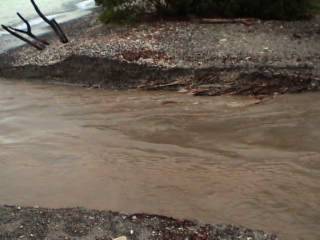Berm Break Mosquito Bay, September 2003
Culebra's Mosquito Bay watershed terminates in a salt flat wetland. During periods of extremely high tide, ocean waters flow into the estuary. During periods of heavy rain, fresh water flows out into the bay through a shoreline lagoon. The following photos show the beach berm breaking and the water from the lagoon flowing into the sea. These photos were taken off an extraordinary video captured by Diane Simard and Paul Franklin.
Mosquito Bay is just one of the locations on Culebra now suffering chronic impacts from sediment laden runoff. Two hydrogeologists paid a site visit to the area and both agreed that these impacts were a result of erosion from poorly planned and constructed dirt access roads. They said these impacts could be greatly reduced with some planning and through the implementation of best management engineering practices. The impact seen in these photos comes from the accumulation of sediment in the salt flat wetland.
Dirt washing off the roads also also drains into a series of irrigation ponds that used to be able to aid in the containment and settlement of the sediment. Due to heavy rain events, some ponds have broken or have been completely filled with mud. This sediment is also destroying the value of these ponds as oasis for migratory birds.
The most severe and irreparable impact to Caribbean corals and sea grass comes from this type of impact. Sediment carries with it many microscopic organisms that are proving lethal to corals. The mud obstructs sunlight that the sea grass and corals need for their survival. Eventually the sediment settles and may directly suffocate these benthic organisms. When winds are calm, and the sediment settles, it may not be obvious from the surface of the sea that the area has suffered impacts. When winds pick up however, these sediments are resuspended and can impact the area for decades to come, transforming what used to be crystal clear waters into waters that look more like the Mississippi river, every time surf's up.
Many plants and animals found in the bay are protected by law. The sea grass of the bay is listed Resource Category 1, Critical Habitat for endangered species. The sea grass is also considered Essential Fish Habitat. Hawksbill sea turtles nest on the shore of the bay, and have been documented foraging in these waters. Most recently a grapefruit sized tumor was removed from a turtle in the adjacent bay. The tumors have been associated with declining water quality.
Mosquito bay is also home to coral species that are now candidates for the endangered species list.
Mosquito Bay is just one of the locations on Culebra now suffering chronic impacts from sediment laden runoff. Two hydrogeologists paid a site visit to the area and both agreed that these impacts were a result of erosion from poorly planned and constructed dirt access roads. They said these impacts could be greatly reduced with some planning and through the implementation of best management engineering practices. The impact seen in these photos comes from the accumulation of sediment in the salt flat wetland.
Dirt washing off the roads also also drains into a series of irrigation ponds that used to be able to aid in the containment and settlement of the sediment. Due to heavy rain events, some ponds have broken or have been completely filled with mud. This sediment is also destroying the value of these ponds as oasis for migratory birds.
The most severe and irreparable impact to Caribbean corals and sea grass comes from this type of impact. Sediment carries with it many microscopic organisms that are proving lethal to corals. The mud obstructs sunlight that the sea grass and corals need for their survival. Eventually the sediment settles and may directly suffocate these benthic organisms. When winds are calm, and the sediment settles, it may not be obvious from the surface of the sea that the area has suffered impacts. When winds pick up however, these sediments are resuspended and can impact the area for decades to come, transforming what used to be crystal clear waters into waters that look more like the Mississippi river, every time surf's up.
Many plants and animals found in the bay are protected by law. The sea grass of the bay is listed Resource Category 1, Critical Habitat for endangered species. The sea grass is also considered Essential Fish Habitat. Hawksbill sea turtles nest on the shore of the bay, and have been documented foraging in these waters. Most recently a grapefruit sized tumor was removed from a turtle in the adjacent bay. The tumors have been associated with declining water quality.
Mosquito bay is also home to coral species that are now candidates for the endangered species list.








